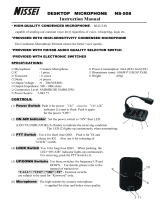
MFJ-434B Instruction Manual Voice Keyer
15
Distorted Recordings from Audio In Jack: Are levels from your audio source exceeding the
keyer's 0-dBm maximum input rating? If so, they must be attenuated.
Weak or Noisy Recordings from Audio In Jack: Are levels from your audio source below the
-23 dBm minimum operating level? If so, they must be boosted in some way.
Voice Keyer Won't Activate PTT line on Playback: Check XMIT switch position.
Pre-recorded Messages Lost: Were higher numbered message slots accidentally overwritten
when recording an excessively long message in a lower numbered slot? Also, check the status of
the REC/PLAY switch. Was message playback attempted with the switch in REC mode? If so,
the memories may have been purged by "dead air".
No Monitor Audio: Is a jack plugged into the Audio Out connector on back? If so, the internal
monitor speaker will be disconnected.
MSG Control Erratic: Check remote jack and any remote control devices attached to it. Was
the remote control ground line connected to chassis ground at some point?
PTT Switch Fails to Halt Message Playback: Check JMP1--a shorting plug must be installed
for the PTT override function to work.
Hum and Distortion: In ham stations where several pieces of equipment are interconnected,
unwanted hum, audio distortion, regeneration, and even sustained AF oscillations may result.
This condition may be caused by RF feedback, but it's more likely an audio system groundloop
(your keyer is heavily protected against RFI). To eliminate RF feedback as the cause, place the
transmitter on a dummy load and run tests at full power level. If the audio problem disappears,
it's probably RF related. If not, there's probably one or more groundloops in your station setup.
Groundloops happen when signal grounds (mic lines, audio output lines, etc) are inadvertently
connected to chassis grounds, or when audio patch cables between units are grounded at both
ends creating multiple return paths. To solve the problem, begin by looking for multiple ground
routes and for interconnected signal and chassis grounds. If eliminating these faults fails to
resolve the condition, try installing isolation transformers on problematic audio lines. The more
audio related equipment you interconnect, the more careful you have to be!
TECHNICAL ASSISTANCE
If you have any problem with this unit first check the appropriate section of this manual. If the
manual does not reference your problem or your problem is not solved by reading the manual,
you may call MFJ Technical Service at 662-323-0549 or the MFJ Factory at 662-323-5869.
You will be best helped if you have your unit, manual and all information on your station handy
so you can answer any questions the technicians may ask.
You can also send questions by mail to MFJ Enterprises, Inc., 300 Industrial Park Road,
Starkville, MS 39759; by Facsimile (FAX) to 662-323-6551; or by email to
exactly how you are using your unit, and a complete description of your station.






























